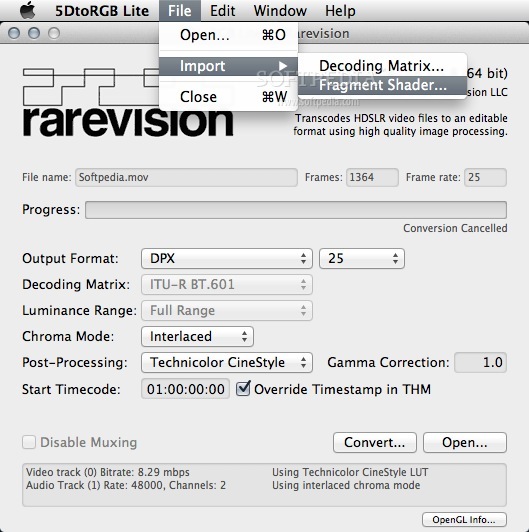

During transcoding 5D2RGB can change 60p to 23,98p or whatever mts (GH2) as originals in Premiere, and I didn't find any permanent damage to the footage with any of the methods - as long as you do the contrast balancing described above manually and don't just hit auto balance.ĥD2RGB is useful though for FCP X, because you may not have Cinema Tools, that allowed you to flag a clip with a different frame rate (within Premiere you right-click >interpret footage and change the frame rate). I tried the different settings of 5D2RGB, I tried ordinary Quicktime (did you know, that there is no gammashift in Quicktime anymore since Lion?), I tried. In FCP X grading is not only completely done with highest precision, it is also no longer an effect, but just the always available info of the clip - just never, never, never use the secret analyzing, auto-balancing and autocorrecting method FCP X offers you when you import media! Let these things be done by Motion (where you change the bit depths in the projects properties, as in After Effects). As you can see, there are also many, many effects without 32-bit rendering. There is this list, however, and there you see the little ¹ that indicates 32-bit-filters, the Color-Correctors are among them. Never use just one effect without the 32bit-icon!įCP7 does not show you if a filter uses 8-bit or 32-bit. Premiere shows you the quality of any filter as an icon right to the filter's name in the list, it is something like a folder with "32" in the middle. Do all this with 32-bit floating point precision. Lower the highlights until they all are crumbled under the "100"-line (some of them will go to 110 or so) and you'll get better defined whites, raise the shadows to "0", but not higher or you will get fog. I didn't understand why, it has to do with broadcast safety or what have you.The "fix" is quite simple: In your NLE (not limited to Premiere or FCP) open the luma waveform monitor. Stu Maschwitz describes the limiting of values (that is cutting off blacks and whites) in his DV Rebel, and for DV, hence the name. I accidentally shot the band shots with this setting, and so pulldown was performed by After Effects CS6, then dynamically linked into a Premiere CS6 timeline.Chroma key was removed using Key Light in After Effects CS6.These are not exactly new "problems".

The C100 has the curious option of shooting AVCHD with 3:2 pulldown. The band consisted of: Marco Landa - keys, Gary Feist - bass, and Ernie Durawa - drums The Lumix lens is a fairer representation.Īustin Skyline background and chroma key wall courtesy of Broadway Digital. I felt that the Rokinon Cine 24mm was softer than the 35mm version, and feel the GH2 suffers from this slightly as I primarily paired those two. In hindsight, perhaps I should have either WhiBal'd both cameras together (which I did for the band shots) or spent some time trying to make the GH2 match better, though people have been trying this with the AF100 too and it's still hit-or-miss. I used a WhiBal card to set the balance on the C100, then matched the reported Kelvin manually on the GH2. The color difference stands out, along with contrast, but I adjusted that in post (the sole image adjustment I performed).
#5DTORGB GH2 WINDOWS#
I intended to do the entire test using Flow Motion, but ran into a bug where it "rained" in the shots, which is a known bug, and those shots were transcoded to ProRes 4:2:2 HQ via the Windows 圆4 version of 5DtoRGB. GH2 hacked with Sedna AQ1 and Flow Motion 2.02 and the picture style was set to Standard, -2, -2, -1, -2. Canon C100 was set to 1/48 and the EOS Standard picture style.


 0 kommentar(er)
0 kommentar(er)
